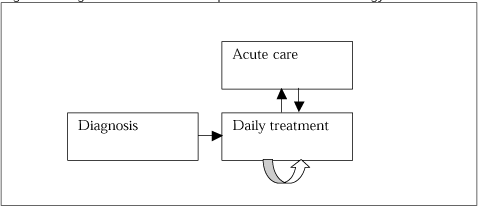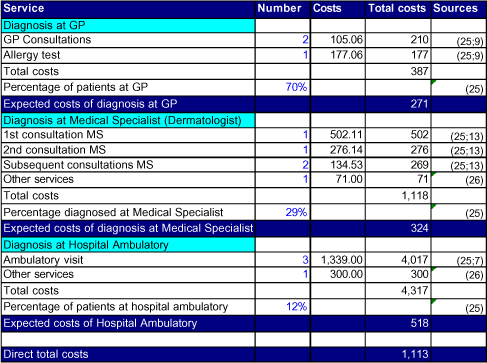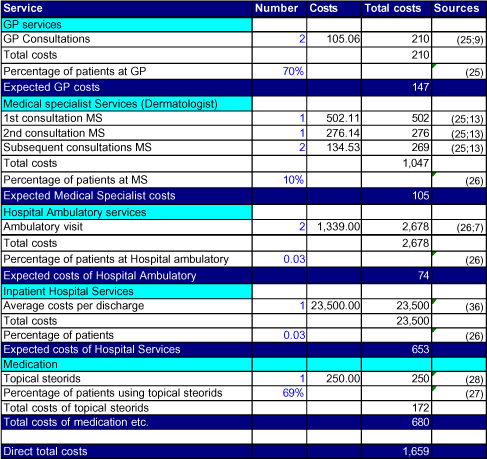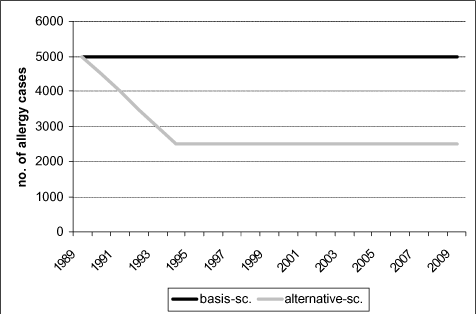|
Valuation of Chemical related Health Impacts 7 Contact AllergyContact allergy is caused by small chemicals that penetrate the skin. By doing this the chemicals can induce allergy. The process of inducing allergy is called sensitisation and is without clinical symptoms. Once a person has become sensitized re-exposure to the allergen can cause allergic eczema. Allergic eczema is characterised by erythema, oedema, and the skin can become dry, shift and fissures develops. 7.1 DefinitionContact allergy is defined as acute or chronic inflammation produced by substances contacting the skin and causing allergic reactions. The contact allergy analysed in this section is classified as L23 (Dermatitis contactus allergica) in the ICD-10 classification of diseases. Starting age for contact allergy is assumed to be at the age of 40. 7.2 Chemicals associated with contact allergyContact allergy from chemicals may arise in connection with private use as well as part of the working environment. Product groups containing chemicals with risk of contact allergy are:
The most frequent cause of contact allergy is the metal - nickel. Second to this, perfumes and preservatives. It is not possible to be cured from contact allergy. However, it is possible to some extent to remove the allergen. By doing this, the patient can be cured from having allergic reacting. However, the patient will have recurrence of the symptoms when exposed to the allergen again. 7.3 Disease courseThe disease course is divided into the following disease states: Diagnosis, Daily treatment and Acute care. The purpose is to have well defined disease states where cost of treatment can be estimated within each disease state. Diagnosis is the state where the patient is having allergic reactions and the diagnosis is in the process of being settled. Daily treatment with contact allergy is the every day coping with contact allergy. This may include daily treatment with topical agents, moistures and avoidance of certain chemicals. This treatment is opposed to Acute care. Acute care is when the patient is having an allergic reaction which requires specific treatment that is not included in the long term management of the disease; i.e. additional treatment due to an acute allergic reaction. Once the patient is allergic toward one substance, it increases the likelihood of becoming allergic towards other substances. Figure 7-1 Diagnosis and treatment of patients with contact allergy
Diagnosis The patient is diagnosed as having contact allergy due to chemicals Once a person has acquired contact allergy, the person will have it for the rest of the life (Duus and Menné (2003)). It is known that one type of contact allergy increases the likelihood of becoming allergic towards other substances (Duus and Menné (2003)). This is taken into account as costs of multi-allergy are included in the average cost estimates. 7.4 Direct health care costsDirect health care costs are estimated for establishing the diagnosis and daily living with contact allergy. Costs of acute care are included in the costs of daily treatment as separate data for acute care and daily living are not available. DiagnosisDiagnosis includes all activities related to diagnosing the patient. This is done at the GP, Medical Specialist or at hospital ambulatory. Direct total costs of establishing the diagnosis are estimated to be DKK 1,113 (Table 7-1). Table 7-1 Direct total cost of establishing diagnosis for a patient with contact allergy (DKK 2002 values)
GP General Practitioner Daily treatment for contact allergyDaily treatment for contact allergy includes all activities related to managing the disease when the diagnosis is settled. This is the daily routine treatment of the disease. This include medication, routine visits to GP, Medical specialists, Ambulatory services, Hospital services, etc. Treatment related to acute care is included in this category also. Estimated yearly costs of treatment are DKK 1,659 (Table 7-2). The major contributors to these costs are hospitals services and medication. Table 7-2 Direct total cost of yearly treatment for a patient with contact allergy (DKK 2002 values)
GP: General Practitioner 7.5 Individual welfare lossEstimates of WTP for avoiding contact allergy have not been found. In RPA(2003) an estimate of one additional day with skin disease is provided. This is based on the lowest value of the estimates in Navrud (1997), which is DKK 109, without any clear reason for this. As an alternative, it has been chosen to estimate the WTP from estimations of WTP of a "symptom day", defined as "one day with mildly, red watering, itchy eyes and runny nose". The value is from a very extensive European morbidity valuation study. The study is often referred to as the 5-country study (CSERGE et. al., 1999 referred in Rainer and Bickel, 2001) and has been the basis for a number of values in Extern E and BeTa. The survey CV study valuing 6 morbidity episodes in the Netherlands, Norway, Portugal, Spain and the UK and arrogated to values for a pool of the 5 countries. The morbidity episodes were all related to air pollution, but the survey was carried out in a context free mode, i.e. by seeking WTP for changes in given health effects only. The basic idea is that context free WTP provides a core value that might be transferred to other areas. In the survey, a "symptom day" is about 83 DKK in 2002-prices. Corrected for income and purchasing power differences this corresponds to DKK 100. Even though it is problematic to use this estimate in the present context it is found to be the best possibility available at this stage. The number of symptom days varies greatly from patient to patient. Here, it is assumed that symptoms will be present approximately 20% of the time, resulting in an estimate of DKK 7,315 per year. It is implicitly assumed that the WTP per symptom day is constant independent of the number of symptom days. There is no basis for determine how the value will depend on the number of days. There could for example be threshold limits partly or fully offsetting the effect of the "standard" assumption of declining marginal WTP values. It can be discussed whether the private medical expenditures should be added or not. Since the WTP estimate is taken from another context, the medical expenditures connected with contact allergy will not be present in this estimate. On the other hand, the estimate may include private expenditures for other kinds of medicine. Since medical expenses of a symptom day as defined in the original WTP study are likely to be rather limited, it seems most reasonable to add private medical expenses to the WTP estimate. Based on information from Department of Dermatology in Denmark, it is estimated that each patient in average has additional expenses on lotion corresponding to DKK 200 per month. Furthermore, topical steroids may be used. The average private expenses in this relation is estimated to app. DKK 250 per year In addition to this, some patients may have expenses for special gloves, but this is left out in the present study. In total, this results in private expenses of DKK 2,650 per year In total, the individual welfare loss amounts DKK 9,965 per year. 7.6 Production lossIn Flyvholm and Burr (2001) the absence from work due to contact allergy is estimated to 1.6 day per year in average. According to Department of Dermatology, Gentofte University Hospital in Denmark it is likely to be to low, but in absence of better documented data, it was recommend using this estimate. 1.6 days per year results in a production loss value of DKK 853 per year. 7.7 Unit cost estimateThe total results of the unit cost estimation are seen in Table 7-3 below. At a discount rate of 3% the total lifetime cost is DKK 291,288 per patient. The main cost element is the welfare loss, counting for 79% of the value. Table 7-3 Unit cost estimate for contact allergy, lifetime cost per patient (DKK 2002 values)
Starting age for contact allergy: 40 years old The unit cost may seem rather high. This is to a large extent due to the fact that the disease is chronic, and following this, costs will arise each year of the remaining lifetime from the day of diagnosis settlement. The welfare loss expresses the individual's willingness to pay to avoid the disease. Another way to look at this is the compensation paid by insurance companies to individuals with work related eczemas. The average compensation per person with work related eczema is DKK 66,976 (2002 value) (Sundhedsstyrelsen 2001). The costs of compensation are rather small compared to the value of the individual welfare loss which is DKK 230,864 (3% discount rate). One explanation for this deviation is that insurance companies do only pay compensation for damages which can be documented. Therefore, the individual WTP in practice is likely to be higher than the compensation paid by the insurance companies. When costs of compensation are added to the direct health care costs, the total lifetime costs per person are 107,648, when using a 3% discount rate. This amount expresses the costs directly paid by the society. In the section below, an example of how the unit cost estimate may be used in economic assessment is given by performing a, mainly illustrative, calculation of health benefit related to the policy initiative on Nickel in 1989. 7.8 Example of unit cost application: Nickel AllergyThis section is intended to give an illustrative example of how the estimated unit cost values may be used in an economic assessment of a chemical policy initiative. In the following, we illustrate how an economic assessment of the health benefits following the policy initiative could have been carried out using the unit cost estimate developed in the present project. Although, the example is carried out first of all with the purpose of illustrating the applicability of using the estimated unit health benefit values, the example is based on what can be seen as the best available empirical basis. In this way, the example also illustrates the difficulties and uncertainties of making policy analyses that includes benefit assessments. The data regarding the number of nickel cases are to be seen as guesstimates. The difficulty of establishing the impact pathway and quantifying the number of diseases is often the main constraint on the quality of benefit assessment. It is also the case here that such knowledge is not present. Thus, the data used here are very uncertain, although the order of magnitude is believed to be realistic. Nickel is the most frequent cause of contact allergy. Scandinavian surveys from the 1980's showed that approximately 20% of all women were allergic to nickel. In order to reduce this negative health effect, a statutory order limiting the permitted release of nickel from metal objects intended for close contact with the skin such as earrings, spectacle frames and buttons came into force in Denmark in 1989 (and followed by a revision in 1991). 7.8.1 Scenario definitionFirst, the policy initiative must be carefully defined along with a definition of the baseline of the assessment, which in most cases refers to the situation if the initiative had not been realised. The policy initiative, reflected in the alternative scenario, is a situation where the statutory order on Nickel is implemented and complied with from 1989 and each year from this date. The base line is defined as the situation without the statutory order. Here, it is assumed that nickel will be used in the same amount as before 1989 during each year from that date. In reality the time horizon of the calculation should be infinite. Due to the discounting of future effects, however, effects arising far in the future have relatively little importance for the total result. Furthermore, effects arising far in the future are subject to relative high uncertainty. For these reasons, therefore, the time horizon of the present case calculation has been set to 20 years. 7.8.2 Mapping of impactsThe assumptions regarding development of number of nickel allergy cases under basis and alternative scenario are based on information from Department of Dermatology, combined with rough assumption made by the consultant for this purpose. On the benefit side the effect of the initiative was expected to be fewer cases of nickel allergy. In baseline, approximately 5,000 new cases of nickel allergy are assumed to be expected yearly. For simplicity is assumed that this number would be constant over the entire time horizon In the alternative scenario it is assumed that the number of cases decreases with 50%, resulting 2,500 avoided cases of nickel allergy yearly. The full effect of the statutory order, however, is not expected to be seen before a number of years, 5 years assumed here, meaning that the full effect is seen from 1994. The development in number of cases of nickel allergy under basis and alternative scenario is seen in Figure 7-2 below13. Figure 7-2: Assumed development in no. of allergy cases under basis and alt. scenario
7.8.3 Valuation of impactsThe health benefits are valued by the unit cost estimated in the present project. The estimated unit value of DKK 291,288 includes lifetime costs for the average patient. The benefits each year using a discount rate of 3% is seen in Table 7-4 below. Table 7-4: NPV of health benefits from reducing use of nickel, million DKK, 2002 prices
Adding the annual benefit from avoided allergy cases over the time horizon of 20 years results in a net total present value (NPV) of DKK 9.7 billion. Along with this assessment, a sensitivity analyses should be carried out. In Table 7-5 the total assessment result is seen for low, best and high unit cost estimate. The assumption behind the estimates for the low and the high unit cost is given in section 10.2.2. Table 7-5: Low and high NPV of health benefits, M. DKK, 2002-prices
The assessment thus shows that the total benefits following the policy initiative are within the range of m. DKK 2,700 and 22,900. As the number of avoided cases of nickel allergy is also subject to significant uncertainty, the total range of values could be wider than indicated in the table. However, if the range of uncertainty for the number of avoided cases is not much higher than a factor of 2 to 3 and the uncertainty in estimating the number of cases is independent of the uncertainty of the unit cost estimates, then the total range of expected benefits is not much different from the range illustrated in Table 7-5. The example shows the usefulness of having unit costs per disease. Undertaking cost-benefit analysis of new policy proposals require that the whole impact pathways can be described and the final effects in terms of a number of reduced diseases can be quantified. In the example such estimation was possible, although highly uncertain. In order cases, the unit costs can be use to perform a backward calculation. If the cost of a new regulation is known, then the number of cases of the disease that has to be avoided for the benefit to excess costs can be estimated. Footnotes13 This development pattern is based on expert judgement but including rough assumptions made by the consultant for the present purpose.
|





